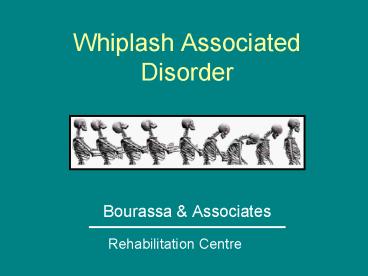Whiplash Associated Disorder - PowerPoint PPT Presentation
1 / 13
Title:
Whiplash Associated Disorder
Description:
... causes of whiplash include contact sports injuries, blows to the head from a ... disorder can leave the cervical spine at greater risk for re-injury. ... – PowerPoint PPT presentation
Number of Views:447
Avg rating:3.0/5.0
Title: Whiplash Associated Disorder
1
Whiplash Associated Disorder
- Bourassa Associates
Rehabilitation Centre
2
What is Whiplash?
- Whiplash is a non-medical term used to describe
neck pain following hyperflexion or
hyperextension of the tissues and joints of the
neck. - Tissues include ligaments, tendons and muscles.
- It is caused by an abnormal motion or force
applied to your neck that causes movement beyond
the neck's normal range of motion.
3
When Does WAD Occur?
- The most frequent cause of whiplash is a car
accident. - Other common causes of whiplash include contact
sports injuries, blows to the head from a falling
object or being assaulted. - Repetitive stress injuries or chronic strain
involving the neck (such as using your neck to
hold the phone) are common, non-acute causes. ??
4
Grades of Whiplash Based on Quebec Task Force
grades of disorder
- Grade 1
- Complaints of neck pain, stiffness or tenderness
- Range of motion is full and assessing
practitioner is not able to illicit pain in the
clients neck with general neck testing.
5
Grades of Whiplash Based on Quebec Task Force
grades of disorder
- Grade 2
- Neck complaints similar to those
- described in grade 1.
- Plus, the examining practitioner
- finds decreased range of motion
- and point tenderness in the neck.
6
Grades of Whiplash Based on Quebec Task Force
grades of disorder
- Grade 3
- Decreased range of motion plus neurological signs
such as decreased deep tendon reflexes, weakness,
insomnia and decreases in sensory input.
7
Grades of Whiplash Based on Quebec Task Force
grades of disorder
- Grade 4
- Neck complaints as well as
- fracture, dislocation or injury to
- the spinal cord.
8
Signs Symptoms of Whiplash
- Neck pain
- Tenderness along the back of your neck.
- Muscle spasms (in the side or back of your neck).
- Difficulty moving your head due to neck
discomfort. - Headache
- Pain shooting from your neck into either shoulder
or arm. - Abnormal sensations such as burning or prickling
in the arms radiating from the neck. - Difficulty with swallowing or chewing and
hoarseness which could indicate injury to the
esophagus and larynx.
9
Management of Whiplash
- Use of a soft collar is generally not recommended
as immobility can lead to an increase in
stiffness, discomfort and can slow the healing
process. - Medication- Ibuprofen (Advil) is a non-steroidal
anti-inflammatory medication (NSAID) that can be
taken to control pain and inflammation. - However, there is recent evidence to suggest
that allowing inflammation to occur may be
conducive to the overall recovery of tissues. - MD visit - It is never a bad idea to visit
your family doctor following a traumatic
incident
10
Treatment What a physiotherapist can do!
- A short course of spinal mobilization can help in
restoring normal movement of the cervical joints
to allow for an active therapy program. - Physical therapy helps to increase circulation,
restore range of motion, and promote healing. - The use of modalities such as ultrasound and
electrical stimulation should only be used in the
early stages of treatment to reduce pain and
assist in the start of an active therapy program. - Physical therapists can also provide you with an
appropriate home exercise program.
11
Prevention of Re-injury
- Whiplash associated disorder can leave the
cervical spine at greater risk for re-injury. - Performance of a home program which consists of
appropriate strengthening and stretching
exercises is recommended. - This will allow for appropriate tissue healing
and readiness of those tissues to undertake
increased tensile forces which reduces the
chances of re-injury or chronic cervical
discomfort. - Physiotherapists are trained to provide you with
this sort of exercise program.
12
Prevention Head Rest Position
- How To Correctly Position Your Car Seat Headrest?
- Take someone with you and go out to your car.
- Sit in your normal seat and see where the
headrest lines up with the back of your head. - Ask the person with you to adjust the headrest so
that the top middle part of the headrest is level
with the height of your eyes - More often than not it is not in the correct
position - you should adjust it and do this
everytime you get into someone else's car. - Also take a moment to explain to them how to
adjust their headrest. - http//www.thewhiplashexperts.co.uk/headrest.html
13
THE END

